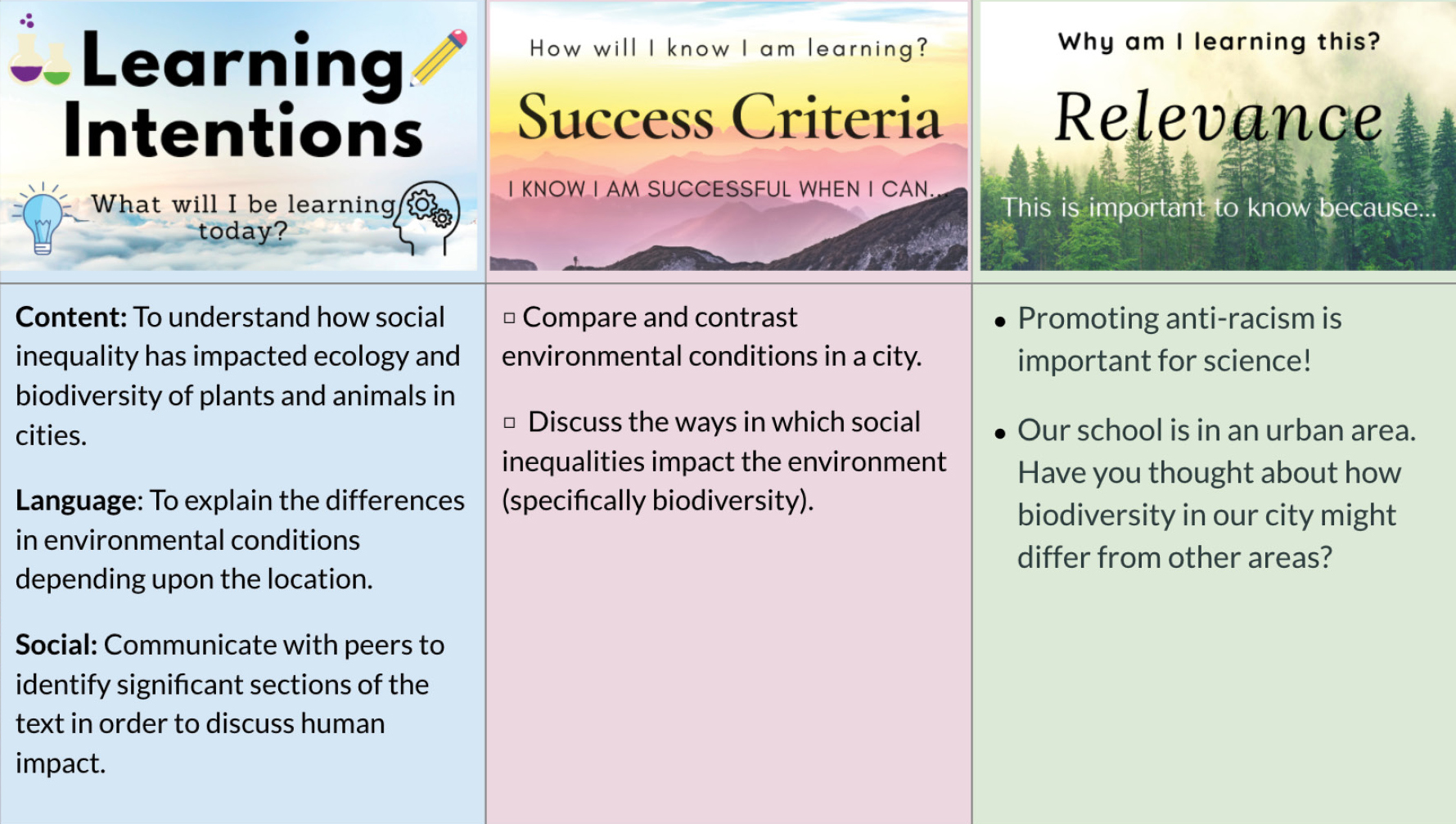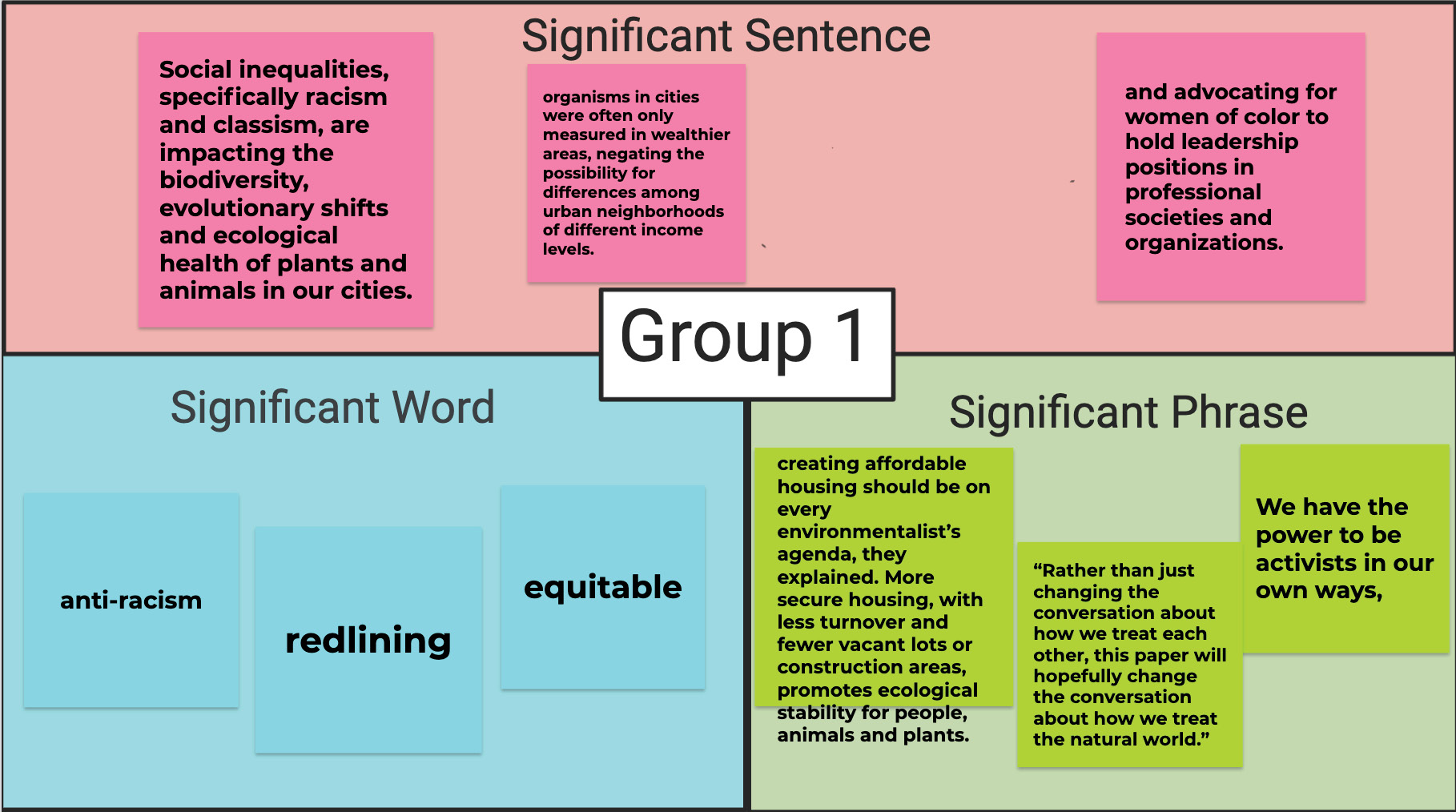feature
Teaching Environmental Social Justice
“My advice is to BE AWARE”
The Science Teacher—November/December 2022 (Volume 90, Issue 2)
By Donna L. Ross, Kimberly Elliot, and Jeff Bonine

There was a time when science was viewed as inherently objective, without bias. We now know that isn’t true—scientists bring their life experiences and beliefs with them to work. The designing, funding, and reporting of research are all framed by societal influences and implemented by those who have been privileged to serve in these roles. Mackenzie (2020) points out that our curriculum should help students understand the context in which science is conducted and ask questions such as: Who makes the decisions? and Who is left out or silenced in the decision-making? A focus on social justice should be central to our teaching, in the same way we consciously support students to understand other aspects of the nature of science. As Bell (2020) argues, students have the right to be taught that science is implicated and situated in a range of social inequities. Teachers have a responsibility to develop lessons that emphasize the need for diverse perspectives among all science stakeholders. We want our science students to be agents of change, but knowing where to begin can be daunting. In this article, we argue that science teachers can start today by incorporating news articles and discussions into their existing units of study.
Context
Following the racial justice movement of 2020, the staff at this urban high school committed to increasing opportunities for students to learn about social justice throughout all content areas. Teachers participated in social justice professional development and pledged to modify their existing units this year, with a longer-term goal of developing new units centered around social justice.
The ecology unit described in this article was taught to a mix of 9th- and 10th-grade students in six biology classes, totaling 123 students (see Table 1). Due to COVID-19, this school was implementing a distance learning model of instruction. Using a variety of online tools, the classes were offered in 90-minute synchronous block periods four times a week, coupled with additional asynchronous learning tasks.
This was the first introduction students had to high school-level ecology, and they explored the relationships among organisms and their environments from various perspectives. The entire unit addressed multiple performance expectations, but this article focuses on three lessons centering on factors that impact biodiversity in order to create solutions to major threats to the environment (HS-LS2-7). In addition to the NGSS, teachers at the school used the framework for antibias teaching (Teaching Tolerance 2020) and applicable Social Justice Standards (SJS) (see Table 2). Integrating articles on social justice issues can leverage science learning, and ultimately be used to empower students to use their voices to advocate for change. In the online resources, we have provided a draft letter that can be sent to families to inform them of the upcoming science and social justice topics in the unit.
Target lesson 1: #BlackBirdersweek
In the beginning of the ecology unit, students discussed the Central Park incident that occurred on May 25, 2020, in which a White woman called police and falsely claimed a bird-watching Black man threatened her. In response to this event, students considered the importance of having diverse representation in science (SJS Identity 1). Using a text rendering strategy (see Table 3), students read the “#BlackBirdersWeek Seeks to Open the Outdoors for Everyone” article in Science News Explores and selected a sentence, phrase, and single word that stood out to them to record in their digital science notebooks. Text rendering was selected because it “allows students to make decisions regarding the importance of the text, select the portions that are most meaningful to them, and then share it with classmates” (Davis-Haley 2004, p. 268). To differentiate instruction, the teacher provided options for students to engage with the text. The students could either listen to the teacher read the article aloud or mute the Zoom volume and read silently. Then as a class, students observed the teacher modeling (through the use of a think-aloud) her selection of a significant word, phrase, and sentence from a paragraph. She then showed them how to post the selections on a Google Jamboard, which had been previously prepared with a template showing where to post each significant word, phrase, and sentence. Students then posted their individual selections for the entire article on a Google Jamboard designated for each group. Groups were formed using the alternate ranking system (Frey, Hattie, and Fisher 2018). The teacher used this system to privately rank her students based on their academic performance on the previous unit of study. Then, she divided the list at the midpoint and formed groups of four by selecting the top two names on each list to form the first group, the next two names on each list to form the second group, and so on. In this way, the groups shared characteristics of both homogeneous and heterogeneous grouping, without having too large of a range of performances in any group. In Zoom breakout rooms, students took turns sharing their work. Then, after a whole-class discussion, students posted their personal takeaways from the activity. Figure 1 shows examples of the work one group produced while in their Zoom breakout room. Multiple students chose “bias” as their significant word, leading to a whole-class discussion about the bias found in science and society (SJS Diversity 10). And one student identified the sentence, “But just because many people believe something doesn’t mean it’s true.” This allowed for conversations regarding the importance of seeing diverse representation in science to combat stereotypes (SJS Justice 11). Students wondered how the woman in Central Park would have reacted if the common stereotype of a Black man in the park was “birdwatcher.” A powerful takeaway that a student shared was, “One event can spark a movement.”

Examples of student responses in Zoom breakout room during lesson 1.
After discussing the article, students were pushed to further their thinking regarding the importance of diversity in science with the following discussion board prompt on the Canvas LMS: Why is it important that students view scientists that look like them? Sentence starters were provided to support students in reflecting on their exposure to diverse scientists and how to increase representation (SJS Diversity 10). Student responses included:
Seeing someone who looks like me that achieved the goal I have in mind makes me believe that I too can work towards my dreams. A certain career is not intended for one race.
I haven’t heard about scientists that are Latinx like me. By seeing scientists that do share similarities with me, I think many youth Latinx will be inspired to pursue their dreams without thinking they need to be white.
As a school community, we can educate students on more scientists of color and share their stories since we’re not always told about that.
The majority of students stated that they had not seen themselves represented in science before this class and that stereotypes about who can do science are powerful. Traditionally, this first lesson would have been a text or video introducing biodiversity, but the teacher chose to begin the unit with this engaging activity to provide relevance and set the stage for a social justice lens.
Target lesson 2: The impact of systemic racism on cities and biodiversity
This activity followed a series of lessons that allowed students to explore biodiversity, including: reading text that introduces biodiversity; watching a video about the role of ecosystems, species, and genetic diversity; conducting a biodiversity count in their own neighborhood; and identifying biome-dependent species richness with an online simulation (see online resources). In this second lesson with an explicit social justice focus, students were engaged in determining how social inequality has impacted the biodiversity of plants and animals in different cities (HS-LS2-7; SJS Diversity 10; SJS Justice 13). This lesson began with the teacher previewing the learning intentions, success criteria, relevance, and article title (see Figure 2). Then students were asked to respond to the prompt: What do you wonder about today’s topic? In the Zoom chat, responses included: “I wonder if racism has a large or small impact?” and “How much of an impact do humans have on one another?”

Preview of upcoming lesson to activate prior knowledge and prepare students for the lesson.
After the teacher read the students’ wonderings out loud, students were invited to read the article, “Systemic Racism Has Consequences for All Life in Cities” (see online resources). They followed the same protocol for the text rendering strategy, as mentioned in the previous lesson, and worked in the same small groups throughout the unit to provide continuity and build rapport within the groups. Some words that were identified by students include: anti-racism, redlining, and equitable (see Figure 3). During the whole-class discussion, it was apparent the students were not familiar with the concept of redlining. The teacher anticipated this and had a video ready to show students, to briefly review the history associated with redlining (see online resources). A dynamic whole-class discussion ensued about the connections among redlining, neighborhood inequities, and the impact on biodiversity (SJS Diversity 10; SJS Justice 13). This connection stemmed from a students’ significant sentence, “Social inequalities, specifically racism and classism, are impacting the biodiversity, evolutionary shifts, and ecological health of plants and animals in our cities.” Students identified sentences and phrases that were solution oriented: “advocating for women of color to hold leadership positions in professional societies and organizations,” “creating affordable housing should be on every environmentalist’s agenda,” and “We have the power to be activists in our own ways.”

Example of student work on Google Jamboard during small group work in a Zoom breakout room.
Students then responded to the following prompt on Canvas LMS: How has systemic racism affected ecology and biodiversity in cities? Student responses included:
Systemic racism affects all life in cities including the land all around them and the environment. Racism and other inequalities are reducing biodiversity, increasing urban heat island effects, and having impacts of climate crises across the United States.
Environmental conditions differ because there are fewer trees in low income and racially minoritized neighborhoods in major cities across the United States. Less tree cover means hotter temperatures and fewer plant and animal species.
Overall, students were able to connect how racism leads to inequalities in the biodiversity of racially minoritized cities and neighborhoods (SJS Diversity 10; SJS Justice 13) and to begin to offer potential solutions.
Target lesson 3: Environmental racism
Prior lessons were taught about the importance of biodiversity, and then students learned about specific threats to biodiversity including: overexploitation, habitat destruction, pollution, and climate change. This third social justice lesson connected the impacts of human activity on biodiversity while learning about environmental racism in a local community (HS-LS2-7; SJS Diversity 10; SJS Justice 13). First, students watched a video from Science (see online resources) that discussed the connection between urban planning, housing discrimination based on race, and lack of biodiversity. Students were invited to share their reactions about the content of the video in the Zoom chat. Reactions included, “I feel frustrated. The fact that racial discrimination is so prominent in environmental issues is pretty mind blowing,” “It’s crazy that there is still racial injustice going on, and it goes to show that our country is not equal.”
After debriefing as a class, students read the article, “Environmental Racism and Asthma: Looking Past Barrio Logan as A Public Health Case Study” (see Online Connections). Guiding questions were provided in a graphic organizer (Figure 4; see Online Connections) for students to complete individually as they read. Prior to their reading, the teacher previewed the questions in the graphic organizer with them, modeled how she uses questions to help her focus on key ideas, and provided sentence starters in the graphic organizer. In small groups, students identified the threats to the environment as having a negative impact on biodiversity and the health of the Barrio Logan community. Examples include:
These causes are a threat to biodiversity because it can cause a lot more harm to the local ecosystem; even exhaust from cars on the freeways and pollution from factories are toxic for all life.
We think it’s because the air pollution is really bad for the health of many who live there. Air pollution also impacts biodiversity. It can be a factor of climate change.
The photos of the neighborhoods remind us of how more urban areas have less trees, which also can cause less animals to live there.
A whole-class discussion focused on how the situation in Barrio Logan is an example of environmental racism. Students connected the history of redlining and urban planning from the Science video. Comments included:
We think people of color are being limited with resources and being put more towards unsanitary housing and areas. This neighborhood is mainly a Latino community. They don’t have clean air.
More people in Barrio Logan have asthma because of the air pollution. More factories, freeways, and military were allowed into that neighborhood, causing pollution. This is why it is environmental racism.
The people that live in the community should have more power in making decisions about having housing separated from factories. People can get involved by getting into local politics.
The final part of the lesson allowed students to record their thoughts about environmental racism and the Barrio Logan article through their creation of a short video, using the app Flip! (formerly Flipgrid) (see Online Connections). For many of the students, the opportunity to make a short video was a welcome break from their frequent writing exercises, but as a differentiation strategy for students who were uncomfortable with filming, the teacher scheduled one-on-one time in a Zoom breakout room for students to share their responses instead of recording them. In addition to discussing environmental justice, students provided advice for people who live in the Barrio Logan community:
Some advice for the people in Barrio Logan is to fight for some of these changes and to try to control what gets put in your community and to not let people who have never lived there dictate what gets put in your community knowing that it can be harmful to you and your kids.
My advice is to BE AWARE! Be aware what is happening within your community, have the government take accountability for what they are doing within these communities and how they are being racially discriminated against.
Conclusion
The last lesson bridged the NGSS and social justice in a way that was particularly meaningful because it centered on a local community. The Framework for K–12 Science Education (NRC 2012, p. 277) argues that equity should be at “the forefront of any effort to improve” science education for all students. Many high school science teachers are not yet explicitly integrating issues of social justice into their instruction. We argue that it is never too early to start. It is possible to build on existing units of study by incorporating current events, news articles, and local issues. Simply by paying attention to news in our own communities and talking with local leaders—particularly those who represent underrepresented populations—teachers can identify social justice topics to incorporate into science teaching. As Foster (2020) argues, we have a responsibility to our students and our communities to teach science in a manner that moves us toward a more socially just world. And we should begin today.
Online Connections
Tables 1–3: https://www.nsta.org/sites/default/files/journal-articles/TST90-2/ross_tables.pdf
Supplementary materials: https://bit.ly/3M7Cei6
#BlackBirdersWeek article: https://www.sciencenewsforstudents.org/article/blackbirdersweek-black-birders-open-the-outdoors-for-everyone
TED-Ed video: Why is Biodiversity So Important? https://www.youtube.com/watch?v=GK_vRtHJZu4&t=3s
HHMI BioInteractive BiomeViewer simulation: https://www.biointeractive.org/classroom-resources/biomeviewer
Systemic Racism has Consequences for All Life in Cities article: https://www.washington.edu/news/2020/08/13/systemic-racism-has-consequences-for-all-life-in-cities/
Systemic Racism Explained: https://www.youtube.com/watch?v=YrHIQIO_bdQ
How Systemic Racism Shaped Ecosystems in U.S. Cities: https://www.sciencemag.org/news/2020/10/how-systemic-racism-shaped-ecosystems-us-cities
Environmental Racism and Asthma: https://ihpsd.github.io/stories/environmental_racism_and_asthma.html
Student Flip! Video: https://drive.google.com/file/d/1BxUocSjYEYnJTDuzRwvbVO-_JSmgt3uP/view?usp=sharing
Donna L. Ross (dlross@sdsu.edu) is an associate professor of science education at San Diego State University, San Diego, CA. Kimberly Elliot (kelliot@hshmc.org) is a biology teacher and Jeff Bonine (jbonine@hshmc.org) is a science educator at Health Sciences High and Middle College, San Diego, CA.
Biology Environmental Science Equity Life Science Multicultural Social Justice


